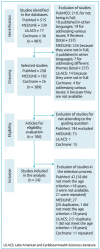ANTIBIOTICS FOR APPENDICECTOMY IN CHILDREN AND ADOLESCENTS DURING THE PERIOPERATIVE PERIOD: AN INTEGRATIVE REVIEW
- PMID: 31291445
- PMCID: PMC6821483
- DOI: 10.1590/1984-0462/;2019;37;4;00013
ANTIBIOTICS FOR APPENDICECTOMY IN CHILDREN AND ADOLESCENTS DURING THE PERIOPERATIVE PERIOD: AN INTEGRATIVE REVIEW
Abstract
Objective: To analyze the preoperative use of antibiotics in children and adolescents requiring appendectomy.
Data source: Integrative review was performed in the MEDLINE, Latin American and Caribbean Health Sciences (LILACS) and Cochrane databases and the PubMed portal, with no time limit. The keywords used were: appendicitis, child, adolescent and antibacterial with Boolean AND. The articles included were published in Portuguese, English or Spanish and whose participants were under 18 years of age. Review articles and guidelines were excluded. The studies were classified according to their level of evidence and 24 papers were selected.
Data collection and analysis: Seven randomized clinical trial studies (level of evidence II), eight cohorts (level III), seven retrospective observational studies (level V) and two historical documentary analysis (level IV) were selected. The studies addressed antibiotics used in acute appendicitis in both uncomplicated and complicated cases. Antibiotics initiated in the preoperative period showed a decrease in the rates of surgical wound infections. First-line (empiric) regimens were tested for sensitivity to microorganisms in peritoneal material cultures, however the results were controversial. Broad-spectrum antibiotics have been suggested in some studies because they have good coverage, but in others they have not been recommended because of the risk of developing bacterial resistance. Shorter administration time and earlier change to the oral route reduced hospitalization time.
Conclusions: There are several clinical protocols with different antibiotics. However, there is no standardization concerning the type of antibiotic drug, time of use, or route.
Objetivo:: Analisar o uso de antibióticos em crianças e adolescentes no perioperatório de apendicectomia.
Fonte de dados:: Realizou-se uma revisão integrativa, nas bases de dados MEDLINE, Literatura Latino-Americana e do Caribe em Ciências da Saúde (LILACS) e Cochrane e no portal PubMed, sem limite de tempo. As palavras-chave utilizadas foram: apendicite, criança, adolescente e antibacterianos com booleano AND. Os artigos incluídos foram publicados nos idiomas português, inglês ou espanhol e cujos participantes tivessem idade inferior a 18 anos. Os artigos de revisão e diretrizes foram excluídos. A qualidade da evidência foi analisada, e foram selecionados 24 artigos.
Síntese dos dados:: Sobre os estudos selecionados, sete foram ensaios clínicos randomizados (nível de evidência II), oito coortes (nível III), sete observacionais retrospectivos (nível V) e duas análises documentais históricas (nível IV). Os estudos abordaram antibióticos usados na apendicite aguda em suas formas não complicada e complicada. Os antibióticos iniciados no pré-operatório evidenciaram diminuição nas taxas de infecção da ferida cirúrgica. Os esquemas de primeira linha (empíricos) foram testados em relação à sensibilidade dos microrganismos nas culturas de material peritoneal, no entanto os resultados foram controversos. Sugeriram-se antibióticos de amplo espectro em alguns estudos por apresentar boa cobertura, no entanto em outros eles não foram recomendados, pelo risco de desenvolver resistência bacteriana. O menor tempo de administração e a mudança mais precoce para a via oral reduziram o tempo de internação.
Conclusões:: Existe um grande número de protocolos clínicos com antibióticos diversos, no entanto não existe padronização em relação ao tipo de antibiótico, tempo de uso nem via.
Conflict of interest statement
The authors declare no conflict of interests.
Figures
References
-
- Sulu B, Günerhan Y, Palanci Y, Isler B, Caglayan K. Epidemiological and demographic features of appendicitis and influences of several environment factors. Ulus Travma Acil Cerrahi Derg. 2010;16:38–42. - PubMed
-
- Graff LG, Robinson D. Abdominal pain and emergency department evaluation. Emerg Med Clin North Am. 2001;19:123–136. - PubMed
-
- Rothrock SG, Pagane J. Acute appendicitis in children: emergency department diagnosis and a management. Ann Emerg Med. 2000;36:39–51. - PubMed
-
- Nadler EP, Gaines BA. Therapeutic Agents Committee of the Surgical Infection Society The Surgical Infection Society guidelines on antimicrobial therapy for children with appendicitis. Surg Infect (Larchmt) 2008;9:75–83. - PubMed
-
- Souza MT, Silva MD, Carvalho R. Integrative review: what is it? How to do it? Einstein (Sao Paulo) 2010;8:102–106. - PubMed
Publication types
MeSH terms
Substances
LinkOut - more resources
Full Text Sources
Medical


